True crime documentaries have had a bit of a sensationalist streak in recent years, but thankfully, Never Let Him Go never stoops to that level. It knows, respects, and empathizes with Scott Johnson and his family, who, for 30 years have relentlessly sought answers as to how and why, exactly, Scott died the way he did. An American prodigy studying in Australia, Scott had a bright future ahead of him. But it was cut short when his body was found at the bottom of a cliff, naked and mutilated, with police concluding simply that Scott had committed suicide. Over the course of decades, however, multiple leads would come up that suggest Scott could’ve been one of the many hate crime victims whose violent and bias-motivated end went unacknowledged. In four efficiently edited, objectively studied yet emotionally told episodes, Never Let Him Go tracks this years-long affair and studies how it evolved from a simple unresolved mystery to a landmark case that exposes not just the sorry state the LGBTQ community was subjected to, but the complicated bureaucracy that comes with obtaining justice.
Synopsis
In December 1988, Scott Johnson, a gay American mathematician, was found dead beneath a cliff in Sydney, Australia. His death was quickly determined to be a suicide. But Steve Johnson, Scott's older brother, had doubts and would spend the next 35 years trying to solve the mystery of Scott's death. He could have never imagined the tinderbox he would crack open—a wave of anti-gay violence, which was systematically ignored for decades.
Storyline
Never Let Him Go is a four-part docuseries about the mysterious death of Scott Johnson, an openly gay academic who died overseas, and the grueling, decades-long investigation his brother Steve launched to get to the bottom of the case.
TLDR
One can only hope every true crime documentary produced from here on out gets the same level-headed and respectful treatment Never Let Him Go had.
What stands out
The back and forth between the police in charge of Scott’s case in Australia and his family back in the United States is a surprising highlight in the series. One party is adamant about closing it, but the other refuses to let it go without a sure answer. They both want the same outcome, to know once and for all what happened to Scott, but they’re fueled by completely different motives and follow completely different codes, and the resulting clash is almost as interesting as the case itself. It’s a testament to the filmmakers that no one is painted in the wrong; they’re both given enough space to defend their case, and it explains why so many cases with less of the privilege Scott has remain largely unresolved.




